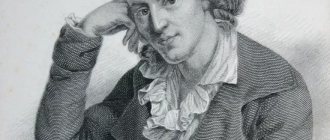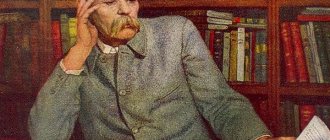“Life is a Dream”: analysis of Calderon’s play
“Life is a Dream” (“La Vida es sueco”) is a “comedy” by Pedro Calderon. It was staged in 1635. Published in the First Part of the Comedies by Calderon in 1636.
Calderon's drama goes back to the Tale of Barlaam and Jehoshaphat, which in turn transformed the life of Buddha in a Christian key. Fearing his son's horoscope, the king imprisons the prince in a tower, from which he, however, emerges to freedom and learns the vanity of existence and true freedom - freedom of spirit. In Spain in the 14th century. Juan Manuel, in The Book of Fortunes, connects this plot with the motif of “the sleeper who has woken up and cannot distinguish sleep from reality”: a person is put to sleep, taken to a palace, where he is treated like a prince, and then returned to his original place. When compiling the genealogy of the characters in the play, the author probably used Suarez de Mendoza’s novel “Eustorgio y Clorirena, historia moscovica,” which reflected the events of the unrest in the Muscovite kingdom (thus, the characters in the “comedy” include Basilio - Vasily Shuisky, Segismundo - among the historical prototypes Polish King Sigismund III, and Astolfo - Prince Vladislav).
“Life is a Dream” by Calderon is considered to be an example of a specific type of “thematic construction” of a text characteristic of the 17th century. in general and Spanish theater in particular. The semantic center of the action is a certain theme-idea (A.A. Parker) - in this case it is included in the title of the play - and all the plot twists, motives of the characters’ behavior and even their characters work towards the fullest disclosure of this idea. This theme, along with the theme “the whole world is a theater,” is one of the most popular commonplaces of the Baroque era. The key to the symbolic plan of the play is usually said to be Plato's "myth of the cave". The seventh book of The Republic tells about people who spend their entire lives in a dark cave, into which only a narrow ray of light penetrates. Their backs are turned to the source of light and they cannot look back because of the chains that bind them. Accustomed to accepting the play of shadows on the wall as reality, they refuse to believe their brother who has been free. Therefore, when Segismundo emerges from the dark tower in animal skins and chains at the beginning of the play, a visible reference to the ancient text immediately sets up an allegorical reading of the action. In this context, Rosaura's fall from her horse, for example, should be clearly read as a sign of her fall from grace. At the same time, the allegorical meaning of the chains on Segismundo is close to Plato’s, but the clothing made of animal skins gives them a new shade: the chains symbolize the shackles of the flesh and earthly existence, and the skins represent the animal being of man. The darkness surrounding the hero, in full agreement with Plato, means an unenlightened mind.
The path of Segismundo is the path of learning the illusory nature of earthly existence: having entered the palace for the first time, he behaves in accordance with his bestial nature, for him there is no other law than his desires. The climax of Segismundo's "atrocities" is the senseless murder of a servant, whom he throws into the sea, only to show that he dares to do it. Returned to the tower, the hero realizes the fragility of the boundary between reality and sleep, the ephemerality of earthly existence, and once again becoming a prince, he strives to behave in such a way that it would not be scary to wake up.
Throughout the play, Segismundo appears before us alternately in two clearly visually distinct guises - a beast-like man in skins and a prince in magnificent clothes. Moreover, in the middle of the play, the external appearance does not correspond to the internal state of the hero: first we see a man-beast in the attire of a prince (that is, at the same time a civilized person and a sovereign), and then a prince in animal skins. This technique allows the author to introduce the motif of the mask and face (no less popular in the 17th century than the motif of the dream of life), the discrepancy between the external and the internal. Moreover, paradoxically, the awareness that appearance does not correspond to the essence, that existence itself is illusory, makes it easier for the hero to fulfill his duty, even frees his will: since he is asleep, he is free to act according to the laws of reason, in a manner inorganic to his nature. Such development of the theme reflects a particularly acute idea, intensely experienced by the theological thought of the era, that true freedom is freedom from earthly passions, and the highest manifestation of free will is the renunciation of it, its subordination to God. In the image of Segismundo, we are presented with a characteristic understanding of the Baroque era of a personality that does not merge with the social role of the individual and acquires genuine and almost absolute freedom insofar as it is aware of the artificiality of this role and the non-identity of itself with it. This inner freedom is emphasized by the almost stylized ease with which Segismundo makes “proper”, “correct” decisions: he forgives Clotaldo and then his father, abandons Rosaura, etc. It looks especially expressive against the backdrop of the rigidity of the laws that have developed in society, requiring, for example, , punishment for the soldier who freed the prince from prison, since he had thereby betrayed his king.
Other characters in the play Life is a Dream by Calderon complement and extend aspects of the theme stated in the image of the main character. It is not only the passionate, animal nature that leads a person to errors: Basilio, relying on human reason alone, made a mistake and sinned no less than Segismundo, who first came to the palace. Guided only by the horoscope, he doomed his son to an animal existence, forgetting the extremely popular formula of that era: “the stars indicate, but do not command,” which meant that a person, thanks to the free will granted to him, can fight against the unfavorable arrangement of the stars. And indeed, the prediction of the stars completely comes true, but its meaning turns out to be the opposite of what Basilio saw, who did not remember that the world is ruled not by the stars, but by Divine Providence.
Rosaura, whose fate is in many ways parallel to the fate of Segismundo, spreads and expands the interpretation of earthly, illusory existence. This lady is not at all bestial, but she is a fallen woman, wearing a man’s dress and trying to autocratically, with her own strength, change fate. Of course, the path she has chosen is wrong, but by following it, she adds a very important shade to the semantic palette of the play. With it, the drama includes the traditional motive for the Spanish theater of the Baroque era of the struggle for love and happiness, through the prism of which reality on the stage is almost automatically refracted. This means that the audience of that era, this line of action, no matter how artificial it may seem to us, was perceived as “alive” and “vital.” Moreover, in the iconic and conventional world of Spanish theater, the ending of Rosaura’s story should be considered happy. This means that with this line Calderon shows that you need to dream and sometimes it’s not scary to even completely surrender to sleep. Although life is a dream, for the sleeper it is absolutely real and he does not know any other reality.
A rather cruel demonstration of what happens to a person who wants to escape the sleep of life is the fate of the servant Clarin: having decided to observe what is happening from the side, to avoid participating in events, he immediately dies. Life is given to people only as a dream, and in order to live one must dream.
Source: Encyclopedia of Literary Works / Ed. S.V. Stakhorsky. - M.: VAGRIUS, 1998
The meaning of the play "Life is a Dream"
Calderon's Baroque art is most clearly evident in the drama "Life is a Dream", written in 1635. This work is key not only for the work of the writer himself, but also for all Baroque art. “Life is a Dream” is a multi-problem work. The sources for the plot of the play are varied:
- Christian legends about Jehoshaphat and Barlaam;
- Historical Chronicles;
- Eastern legends about Buddha.
The historical plot of the play is greatly transformed. The location of the work is Poland. This is easy to explain: Poland, like Spain, is a Catholic state. Calderon transforms the chosen plot, making it emblematic. The play “Life is a Dream” is a work about the lot of man on earth in an ethical and religious sense. The main problem of the work is the problem of free will, which is also relevant for Protestants. Protestants have a predetermined destiny, Catholics do not. And this collision is reflected in the play: Basilio believes the predictions and locks Segismundo in prison.
Are you an expert in this subject area? We invite you to become the author of the Directory Working Conditions
The play “Life is a Dream” is the story of Segismundo, who cannot come to an exact understanding of where life is and where sleep is, and how they can be separated. A person lives without fully understanding whether what is happening around him is reality or an illusion. Segismundo concludes that we should always do good, no matter whether we are awake or asleep. Good is an ethical category. And to do good means to be worthy and moral. Here we are talking about understanding the reality of a person and his path as a path of troubles that require self-denial and self-restraint. A person should voluntarily choose the position of limiting his earthly desires.
There are not many characters in Calderon's work, but the action of the play is bifocal. There are two lines of intrigue here, which means there is no unity of action: Rosaura (and Astolfo) and Segismundo (and his life-dream).
Segismundo loves Rosaura, but renounces her because he must restore her honor. For Calderon, it is important that a person understands the limits of his capabilities and does not succumb to the feeling that overwhelms him.
Finished works on a similar topic
Course work Opposition of external and internal freedom in the drama “Life is a Dream” by Calderon 440 ₽ Abstract Opposition of external and internal freedom in the drama “Life is a Dream” by Calderon 270 ₽ Test paper Opposition of external and internal freedom in the drama “Life is a Dream” by Calderon 220 ₽
Receive completed work or specialist advice on your educational project Find out the cost
"Life is a dream." Composition
0
(0)
"Life is a Dream" by Calderon. Composition
Calderon was the creator of a new genre - religious and philosophical drama. As a zealous Catholic, in his play he emphasized the need for a person to pacify his pride and turn his aspirations and desires to God. There is no point, he believed, in despair because life cannot be changed, because it is just a dream. The title of the play already embodies the meaning of baroque culture (“The World is a Theater”).
To a person, according to the playwright, it only seems that her will and desire are capable of changing something in her life. In fact, she is absolutely helpless before the will of God. Therefore, human life itself, the story of Segismundo clearly proved, is ghostly, illusory, like theater or a dream, and not reality. Therefore, the only thing that remains for a person is to accept a predetermined share and curb his rebellious nature.
Obviously, it was important for Calderon to show that the model of life as a dream helped his protagonist to cleanse himself morally. Realizing that all the goals that can be achieved through violence are illusory, Segismundo finally understood the unnecessaryness of violence. This contributed to the fact that he was able to forgive his father. Having done this, the prince amazingly achieved power and glory, the meagerness of which he had recently reflected. Thus, the author, quite in the spirit of Christian teaching, leads the reader to the idea that God rewards the righteous precisely because they do not demand reward. But using the example of Basilio, who decided to overthink God's providence, Calderon proves the impossibility of avoiding what is provided by heaven.
Calderon's work is thoroughly allegorical. Therefore, the relationship between Segismundo and Basilio can also be considered as a model of interaction between God (this role is played by Basilio in the drama) and man (Segismundo). At the same time, man (Segismundo) proves in these respects his right to some correction of God’s plan within the framework of morality.
In the drama, the author uses subtle irony. This is another common baroque technique. After all, it is not only the animal essence of a person that can lead to harmful consequences. Let us remember the first appearance of Segismundo in the palace, when he threw a servant out of the window, threatened Astolfo, and almost raped Rosaur. Thus, errors also occur in rational calculations, which proves the error in the horoscope, through which Basilio almost killed his own son. Blinded by his faith in the sign, the king simply forgets that, according to Christian doctrine, the world is ruled not by the stars, but by God's providence.
No one can turn away fate
For everything, as determined, flows;
What will happen will not pass us by,
And it will happen.
And at the same time, “Life is a Dream” is a social drama, where the formation of Segismundo’s personality, his moral self, is possible through the awareness of his responsibility to others.
Calderon proposed, if not a program for the formation of an ideal monarch, then at least an instructive picture of his self-education and development.
As we see, in this genre the main characters are philosophical ideas, and the characters only voice them. These ideas are embodied through Calderon’s likening of illusion and reality, the clash of consciousness and subconscious. Through the image of a dream, the author covers a number of different themes - the relativity of earthly values, the transience of time, free will, mercy, honor, vassal and parental duty, guilt and redemption, which are closely intertwined in the work.
0 / 5. 0
.







